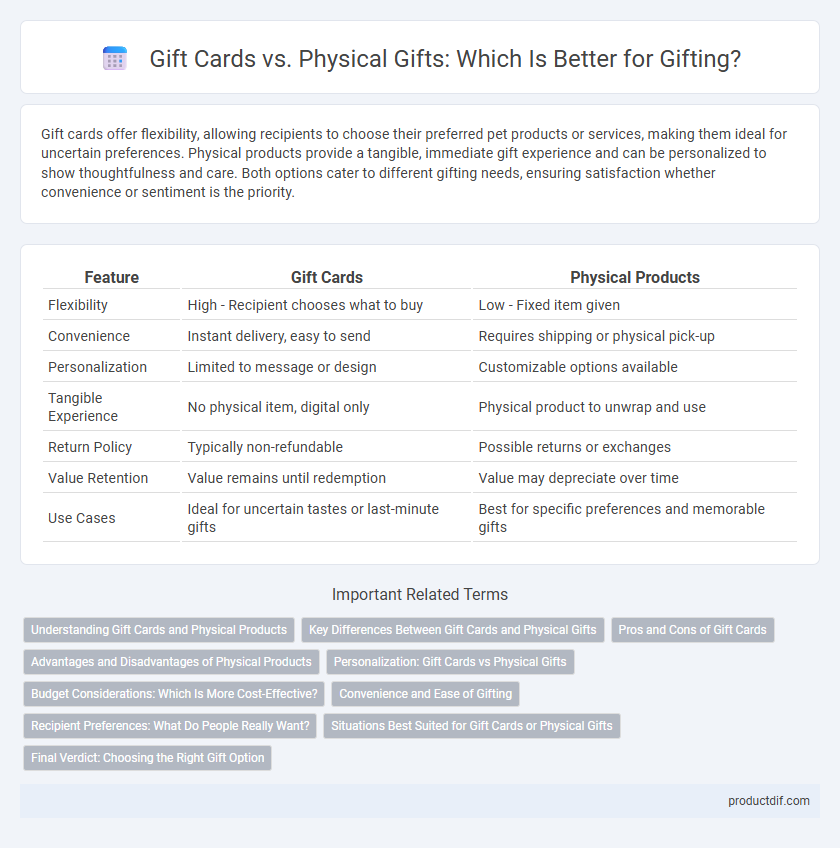Gift cards offer flexibility, allowing recipients to choose their preferred pet products or services, making them ideal for uncertain preferences. Physical products provide a tangible, immediate gift experience and can be personalized to show thoughtfulness and care. Both options cater to different gifting needs, ensuring satisfaction whether convenience or sentiment is the priority.
Table of Comparison
| Feature | Gift Cards | Physical Products |
|---|---|---|
| Flexibility | High - Recipient chooses what to buy | Low - Fixed item given |
| Convenience | Instant delivery, easy to send | Requires shipping or physical pick-up |
| Personalization | Limited to message or design | Customizable options available |
| Tangible Experience | No physical item, digital only | Physical product to unwrap and use |
| Return Policy | Typically non-refundable | Possible returns or exchanges |
| Value Retention | Value remains until redemption | Value may depreciate over time |
| Use Cases | Ideal for uncertain tastes or last-minute gifts | Best for specific preferences and memorable gifts |
Understanding Gift Cards and Physical Products
Gift cards offer versatile options for recipients, allowing them to choose products or services at their convenience, which enhances the gifting experience by eliminating guesswork. Physical products provide tangible, immediate satisfaction and emotional connection through personalized choices and packaging. Understanding the benefits of gift cards versus physical products helps optimize gifting strategies based on recipient preferences and occasion suitability.
Key Differences Between Gift Cards and Physical Gifts
Gift cards offer flexibility by allowing recipients to choose their preferred items, while physical gifts provide a tangible, personalized experience that can create lasting memories. Gift cards are convenient and easy to deliver, especially for remote gifting, whereas physical gifts require careful selection and shipping logistics. Physical products hold sentimental value through customization, but gift cards minimize the risk of unwanted presents and promote budget control.
Pros and Cons of Gift Cards
Gift cards provide convenience and flexibility, allowing recipients to choose products that suit their preferences, reducing the risk of unwanted gifts. They offer easy digital delivery and are ideal for last-minute gifting, but some recipients may find them less personal than physical presents. However, gift cards can incur expiration dates or fees, which may diminish their value over time.
Advantages and Disadvantages of Physical Products
Physical products offer tangible value and can provide immediate satisfaction, making them ideal for personalized or sentimental gifts. However, they require careful selection to match the recipient's preferences and involve shipping costs or delivery delays. Unlike gift cards, physical gifts may also pose challenges in terms of return policies and storage.
Personalization: Gift Cards vs Physical Gifts
Gift cards offer customization through personalized messages and flexible value amounts, allowing recipients to choose products according to their preferences. Physical gifts provide tactile and emotional personalization, such as customized engravings, monograms, or handmade elements that create a unique, tangible experience. Combining both options enhances personalization by merging choice and sentiment in gift-giving.
Budget Considerations: Which Is More Cost-Effective?
Gift cards often provide greater budget flexibility by allowing recipients to choose their preferred items, minimizing the risk of unwanted gifts and wasted spending. Physical products may involve extra costs such as packaging, shipping, and returns, which can inflate the total expenditure. For budget-conscious shoppers, gift cards generally offer a more cost-effective solution by eliminating these additional expenses and reducing the chance of overspending.
Convenience and Ease of Gifting
Gift cards offer unparalleled convenience and ease of gifting by allowing recipients to choose their preferred items at their own pace, eliminating guesswork for the giver. Physical products require careful selection, packaging, and shipping, which can be time-consuming and prone to logistical challenges. Digital delivery of gift cards ensures instant gratification, making them an efficient choice for last-minute or remote gifting occasions.
Recipient Preferences: What Do People Really Want?
Recipient preferences often lean towards gift cards due to their flexibility, allowing individuals to choose products that best fit their tastes and needs. Studies show that 70% of recipients appreciate gift cards for providing autonomy in selection, enhancing satisfaction compared to physical products that may not align with personal preferences. However, some recipients still value physical gifts for their sentimental and tangible qualities, highlighting the importance of understanding the recipient's unique desires.
Situations Best Suited for Gift Cards or Physical Gifts
Gift cards are ideal for situations requiring convenience and flexibility, such as last-minute gifts or when the recipient's preferences are unknown. Physical products best suit occasions where a personal touch or sentimental value is important, like milestone birthdays or anniversaries. Choosing between the two depends on the balance of practicality versus emotional impact in gifting scenarios.
Final Verdict: Choosing the Right Gift Option
Gift cards offer flexibility and convenience, allowing recipients to select items according to their preferences, which reduces the risk of unwanted gifts and simplifies the shopping process. Physical products provide a tangible and personalized experience, often creating lasting memories and emotional connections through thoughtful selection. Choosing the right gift depends on the recipient's taste, occasion, and the giver's intention, balancing practicality with sentiment to ensure the most meaningful impact.
Gift Cards vs Physical Products Infographic

 productdif.com
productdif.com